0|Page. Law. 1|Page The courts have always been the cho
VerifiedAdded on 2023/01/16
|14
|5437
|70
AI Summary
Contribute Materials
Your contribution can guide someone’s learning journey. Share your
documents today.

0 | P a g e
Law
Law
Secure Best Marks with AI Grader
Need help grading? Try our AI Grader for instant feedback on your assignments.
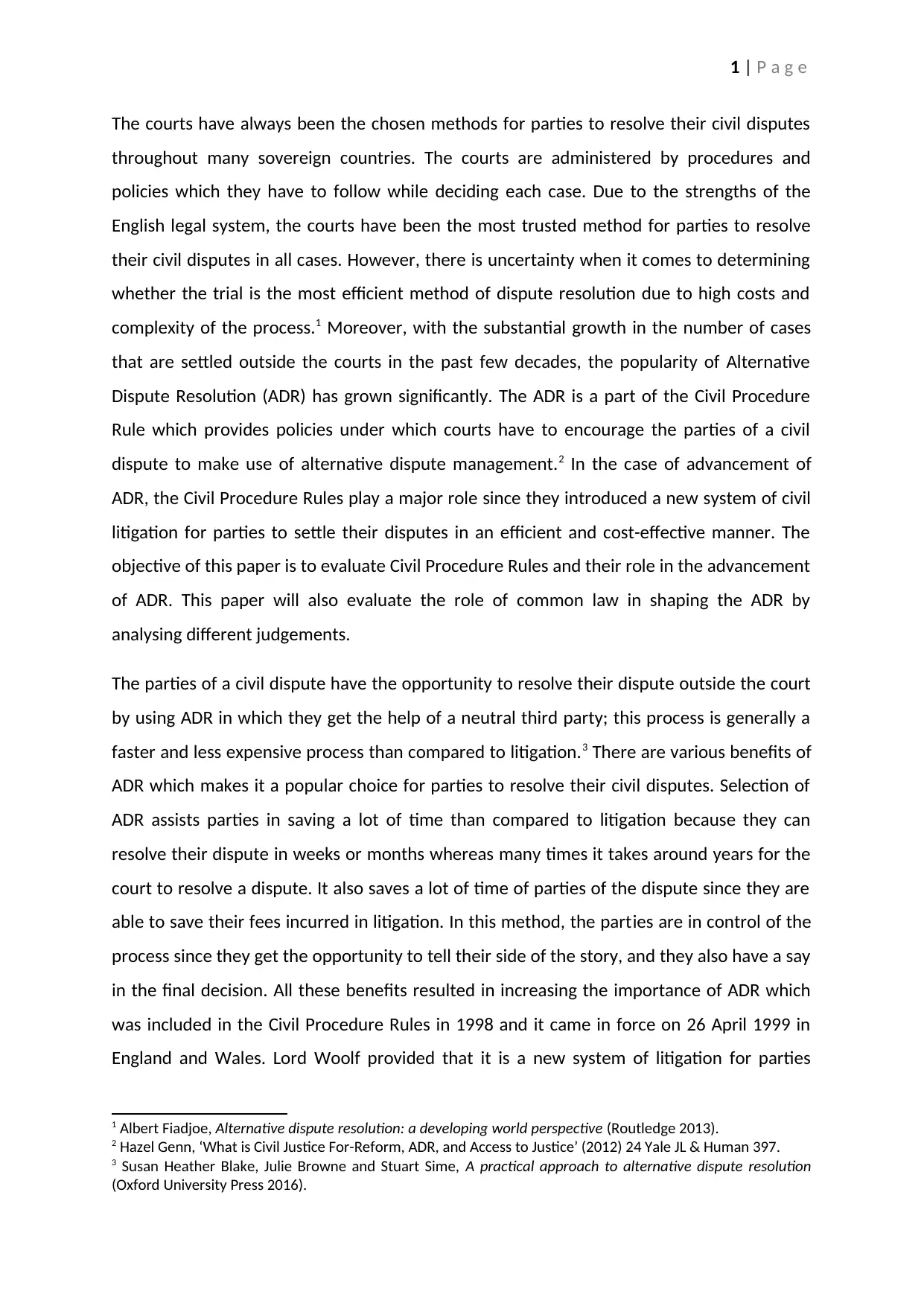
1 | P a g e
The courts have always been the chosen methods for parties to resolve their civil disputes
throughout many sovereign countries. The courts are administered by procedures and
policies which they have to follow while deciding each case. Due to the strengths of the
English legal system, the courts have been the most trusted method for parties to resolve
their civil disputes in all cases. However, there is uncertainty when it comes to determining
whether the trial is the most efficient method of dispute resolution due to high costs and
complexity of the process.1 Moreover, with the substantial growth in the number of cases
that are settled outside the courts in the past few decades, the popularity of Alternative
Dispute Resolution (ADR) has grown significantly. The ADR is a part of the Civil Procedure
Rule which provides policies under which courts have to encourage the parties of a civil
dispute to make use of alternative dispute management.2 In the case of advancement of
ADR, the Civil Procedure Rules play a major role since they introduced a new system of civil
litigation for parties to settle their disputes in an efficient and cost-effective manner. The
objective of this paper is to evaluate Civil Procedure Rules and their role in the advancement
of ADR. This paper will also evaluate the role of common law in shaping the ADR by
analysing different judgements.
The parties of a civil dispute have the opportunity to resolve their dispute outside the court
by using ADR in which they get the help of a neutral third party; this process is generally a
faster and less expensive process than compared to litigation.3 There are various benefits of
ADR which makes it a popular choice for parties to resolve their civil disputes. Selection of
ADR assists parties in saving a lot of time than compared to litigation because they can
resolve their dispute in weeks or months whereas many times it takes around years for the
court to resolve a dispute. It also saves a lot of time of parties of the dispute since they are
able to save their fees incurred in litigation. In this method, the parties are in control of the
process since they get the opportunity to tell their side of the story, and they also have a say
in the final decision. All these benefits resulted in increasing the importance of ADR which
was included in the Civil Procedure Rules in 1998 and it came in force on 26 April 1999 in
England and Wales. Lord Woolf provided that it is a new system of litigation for parties
1 Albert Fiadjoe, Alternative dispute resolution: a developing world perspective (Routledge 2013).
2 Hazel Genn, ‘What is Civil Justice For-Reform, ADR, and Access to Justice’ (2012) 24 Yale JL & Human 397.
3 Susan Heather Blake, Julie Browne and Stuart Sime, A practical approach to alternative dispute resolution
(Oxford University Press 2016).
The courts have always been the chosen methods for parties to resolve their civil disputes
throughout many sovereign countries. The courts are administered by procedures and
policies which they have to follow while deciding each case. Due to the strengths of the
English legal system, the courts have been the most trusted method for parties to resolve
their civil disputes in all cases. However, there is uncertainty when it comes to determining
whether the trial is the most efficient method of dispute resolution due to high costs and
complexity of the process.1 Moreover, with the substantial growth in the number of cases
that are settled outside the courts in the past few decades, the popularity of Alternative
Dispute Resolution (ADR) has grown significantly. The ADR is a part of the Civil Procedure
Rule which provides policies under which courts have to encourage the parties of a civil
dispute to make use of alternative dispute management.2 In the case of advancement of
ADR, the Civil Procedure Rules play a major role since they introduced a new system of civil
litigation for parties to settle their disputes in an efficient and cost-effective manner. The
objective of this paper is to evaluate Civil Procedure Rules and their role in the advancement
of ADR. This paper will also evaluate the role of common law in shaping the ADR by
analysing different judgements.
The parties of a civil dispute have the opportunity to resolve their dispute outside the court
by using ADR in which they get the help of a neutral third party; this process is generally a
faster and less expensive process than compared to litigation.3 There are various benefits of
ADR which makes it a popular choice for parties to resolve their civil disputes. Selection of
ADR assists parties in saving a lot of time than compared to litigation because they can
resolve their dispute in weeks or months whereas many times it takes around years for the
court to resolve a dispute. It also saves a lot of time of parties of the dispute since they are
able to save their fees incurred in litigation. In this method, the parties are in control of the
process since they get the opportunity to tell their side of the story, and they also have a say
in the final decision. All these benefits resulted in increasing the importance of ADR which
was included in the Civil Procedure Rules in 1998 and it came in force on 26 April 1999 in
England and Wales. Lord Woolf provided that it is a new system of litigation for parties
1 Albert Fiadjoe, Alternative dispute resolution: a developing world perspective (Routledge 2013).
2 Hazel Genn, ‘What is Civil Justice For-Reform, ADR, and Access to Justice’ (2012) 24 Yale JL & Human 397.
3 Susan Heather Blake, Julie Browne and Stuart Sime, A practical approach to alternative dispute resolution
(Oxford University Press 2016).
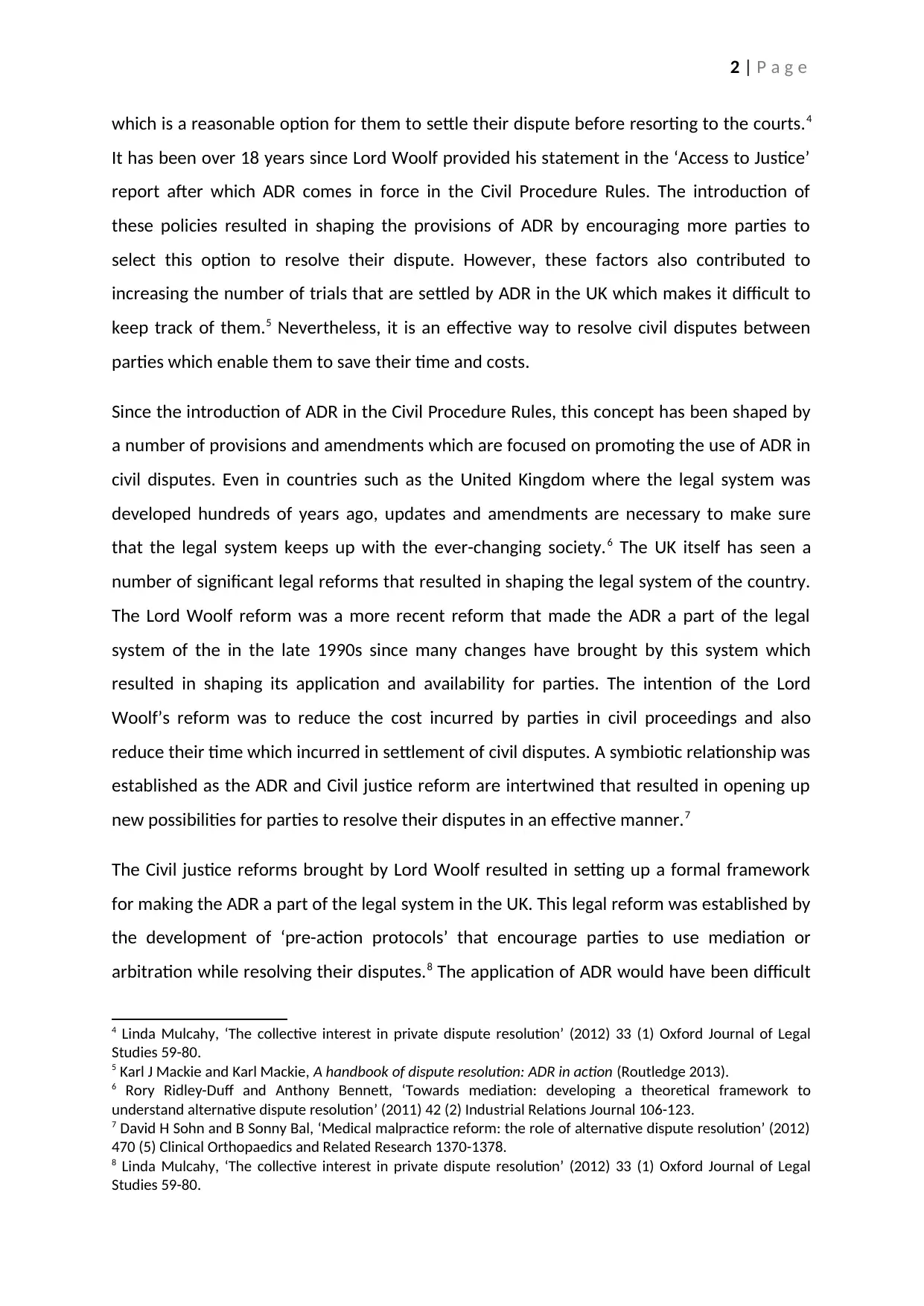
2 | P a g e
which is a reasonable option for them to settle their dispute before resorting to the courts.4
It has been over 18 years since Lord Woolf provided his statement in the ‘Access to Justice’
report after which ADR comes in force in the Civil Procedure Rules. The introduction of
these policies resulted in shaping the provisions of ADR by encouraging more parties to
select this option to resolve their dispute. However, these factors also contributed to
increasing the number of trials that are settled by ADR in the UK which makes it difficult to
keep track of them.5 Nevertheless, it is an effective way to resolve civil disputes between
parties which enable them to save their time and costs.
Since the introduction of ADR in the Civil Procedure Rules, this concept has been shaped by
a number of provisions and amendments which are focused on promoting the use of ADR in
civil disputes. Even in countries such as the United Kingdom where the legal system was
developed hundreds of years ago, updates and amendments are necessary to make sure
that the legal system keeps up with the ever-changing society.6 The UK itself has seen a
number of significant legal reforms that resulted in shaping the legal system of the country.
The Lord Woolf reform was a more recent reform that made the ADR a part of the legal
system of the in the late 1990s since many changes have brought by this system which
resulted in shaping its application and availability for parties. The intention of the Lord
Woolf’s reform was to reduce the cost incurred by parties in civil proceedings and also
reduce their time which incurred in settlement of civil disputes. A symbiotic relationship was
established as the ADR and Civil justice reform are intertwined that resulted in opening up
new possibilities for parties to resolve their disputes in an effective manner.7
The Civil justice reforms brought by Lord Woolf resulted in setting up a formal framework
for making the ADR a part of the legal system in the UK. This legal reform was established by
the development of ‘pre-action protocols’ that encourage parties to use mediation or
arbitration while resolving their disputes.8 The application of ADR would have been difficult
4 Linda Mulcahy, ‘The collective interest in private dispute resolution’ (2012) 33 (1) Oxford Journal of Legal
Studies 59-80.
5 Karl J Mackie and Karl Mackie, A handbook of dispute resolution: ADR in action (Routledge 2013).
6 Rory Ridley-Duff and Anthony Bennett, ‘Towards mediation: developing a theoretical framework to
understand alternative dispute resolution’ (2011) 42 (2) Industrial Relations Journal 106-123.
7 David H Sohn and B Sonny Bal, ‘Medical malpractice reform: the role of alternative dispute resolution’ (2012)
470 (5) Clinical Orthopaedics and Related Research 1370-1378.
8 Linda Mulcahy, ‘The collective interest in private dispute resolution’ (2012) 33 (1) Oxford Journal of Legal
Studies 59-80.
which is a reasonable option for them to settle their dispute before resorting to the courts.4
It has been over 18 years since Lord Woolf provided his statement in the ‘Access to Justice’
report after which ADR comes in force in the Civil Procedure Rules. The introduction of
these policies resulted in shaping the provisions of ADR by encouraging more parties to
select this option to resolve their dispute. However, these factors also contributed to
increasing the number of trials that are settled by ADR in the UK which makes it difficult to
keep track of them.5 Nevertheless, it is an effective way to resolve civil disputes between
parties which enable them to save their time and costs.
Since the introduction of ADR in the Civil Procedure Rules, this concept has been shaped by
a number of provisions and amendments which are focused on promoting the use of ADR in
civil disputes. Even in countries such as the United Kingdom where the legal system was
developed hundreds of years ago, updates and amendments are necessary to make sure
that the legal system keeps up with the ever-changing society.6 The UK itself has seen a
number of significant legal reforms that resulted in shaping the legal system of the country.
The Lord Woolf reform was a more recent reform that made the ADR a part of the legal
system of the in the late 1990s since many changes have brought by this system which
resulted in shaping its application and availability for parties. The intention of the Lord
Woolf’s reform was to reduce the cost incurred by parties in civil proceedings and also
reduce their time which incurred in settlement of civil disputes. A symbiotic relationship was
established as the ADR and Civil justice reform are intertwined that resulted in opening up
new possibilities for parties to resolve their disputes in an effective manner.7
The Civil justice reforms brought by Lord Woolf resulted in setting up a formal framework
for making the ADR a part of the legal system in the UK. This legal reform was established by
the development of ‘pre-action protocols’ that encourage parties to use mediation or
arbitration while resolving their disputes.8 The application of ADR would have been difficult
4 Linda Mulcahy, ‘The collective interest in private dispute resolution’ (2012) 33 (1) Oxford Journal of Legal
Studies 59-80.
5 Karl J Mackie and Karl Mackie, A handbook of dispute resolution: ADR in action (Routledge 2013).
6 Rory Ridley-Duff and Anthony Bennett, ‘Towards mediation: developing a theoretical framework to
understand alternative dispute resolution’ (2011) 42 (2) Industrial Relations Journal 106-123.
7 David H Sohn and B Sonny Bal, ‘Medical malpractice reform: the role of alternative dispute resolution’ (2012)
470 (5) Clinical Orthopaedics and Related Research 1370-1378.
8 Linda Mulcahy, ‘The collective interest in private dispute resolution’ (2012) 33 (1) Oxford Journal of Legal
Studies 59-80.

3 | P a g e
without the provision introduced by Lord Woolf that requires courts to encourage parties to
settle their dispute without litigation. It resulted in shaping the foundation of ADR as it
resulted in becoming a key part of the civil justice system in the UK. Thus, the steps for
encouraging ADR resulted in making it a popular part of the legal system in the UK.
Measures were introduced in the Lord Woolf reform to promote disclosure of documents in
the ADR process which are central to the dispute to establish fairness; the reform also
promotes steps to control legal costs before the parties switch to ADR. However, these
factors also resulted in making parties comfortable with ADR practices because the courts
were encouraging parties to accept the ADR which makes it easier for them to accept this
reform and settle their dispute through this method as it increases their trust in this
system.9
The incorporation of pre-action protocols was a revolutionary step that assisted in shaping
ADR and making it a popular method for parties in the UK to settle their civil dispute. This
provision was brought by Lord Woolf in his report which was focused on increasing
cooperation between parties to a more significant amount to ensure that they share
necessary documents and information in a civil dispute.10 The objective of this provision was
to ensure that both the parties of a dispute must bring forward certain information and
documents before filing a legal dispute or litigation. Due to the sharing of information, the
parties were able to exchange relevant information with each other that enable them to
reach a mutual agreement rather than going to the court for resolving their dispute.
However, it did not mean that the rights of parties to go to the court was prohibit by any
means; instead, this provision was focused on reducing the burden of the courts by
promoting a situation in which both parties were able to reach a mutual agreement to avoid
their legal dispute.11 In all these cases, ADR was pushed to make sure that parties resolve
their dispute outside the court rather than going to the court. Often the provision for ADR
was included in the contractual terms which enforce parties to ensure that they first try to
resolve their dispute through ADR rather than directly filing their case in the court.
9 Tania Soudrin, ‘Civil Dispute Resolution Obligations: What is Reasonable’ (2012) 35 UNSWLJ 889.
10 Oliver Ramsbotham, Hugh Maill and Tom Woodhouse, Contemporary conflict resolution (Polity 2011).
11 Carrie Menkel-Meadow, Dispute processing and conflict resolution: theory, practice and policy (Routledge
2017).
without the provision introduced by Lord Woolf that requires courts to encourage parties to
settle their dispute without litigation. It resulted in shaping the foundation of ADR as it
resulted in becoming a key part of the civil justice system in the UK. Thus, the steps for
encouraging ADR resulted in making it a popular part of the legal system in the UK.
Measures were introduced in the Lord Woolf reform to promote disclosure of documents in
the ADR process which are central to the dispute to establish fairness; the reform also
promotes steps to control legal costs before the parties switch to ADR. However, these
factors also resulted in making parties comfortable with ADR practices because the courts
were encouraging parties to accept the ADR which makes it easier for them to accept this
reform and settle their dispute through this method as it increases their trust in this
system.9
The incorporation of pre-action protocols was a revolutionary step that assisted in shaping
ADR and making it a popular method for parties in the UK to settle their civil dispute. This
provision was brought by Lord Woolf in his report which was focused on increasing
cooperation between parties to a more significant amount to ensure that they share
necessary documents and information in a civil dispute.10 The objective of this provision was
to ensure that both the parties of a dispute must bring forward certain information and
documents before filing a legal dispute or litigation. Due to the sharing of information, the
parties were able to exchange relevant information with each other that enable them to
reach a mutual agreement rather than going to the court for resolving their dispute.
However, it did not mean that the rights of parties to go to the court was prohibit by any
means; instead, this provision was focused on reducing the burden of the courts by
promoting a situation in which both parties were able to reach a mutual agreement to avoid
their legal dispute.11 In all these cases, ADR was pushed to make sure that parties resolve
their dispute outside the court rather than going to the court. Often the provision for ADR
was included in the contractual terms which enforce parties to ensure that they first try to
resolve their dispute through ADR rather than directly filing their case in the court.
9 Tania Soudrin, ‘Civil Dispute Resolution Obligations: What is Reasonable’ (2012) 35 UNSWLJ 889.
10 Oliver Ramsbotham, Hugh Maill and Tom Woodhouse, Contemporary conflict resolution (Polity 2011).
11 Carrie Menkel-Meadow, Dispute processing and conflict resolution: theory, practice and policy (Routledge
2017).
Secure Best Marks with AI Grader
Need help grading? Try our AI Grader for instant feedback on your assignments.
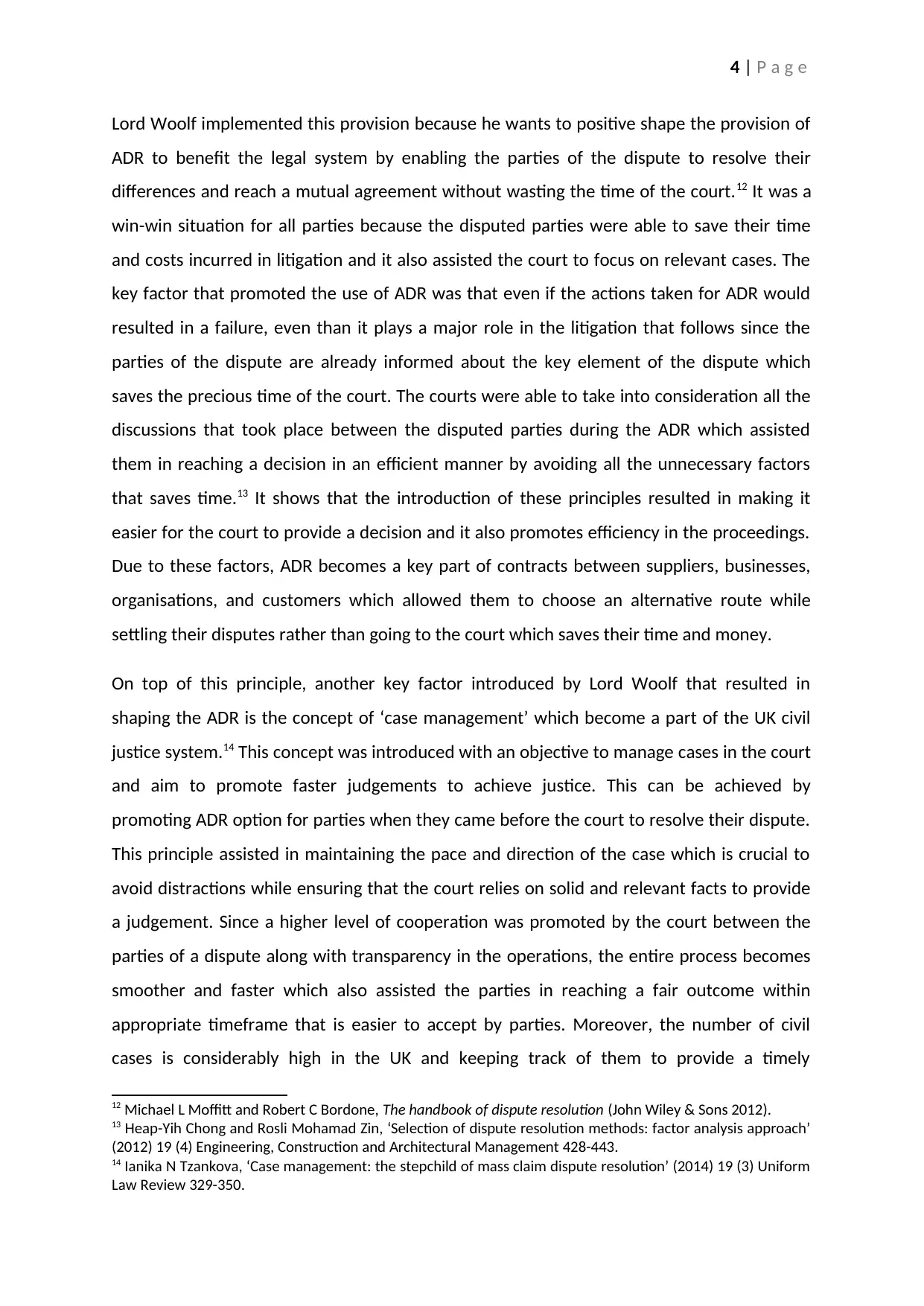
4 | P a g e
Lord Woolf implemented this provision because he wants to positive shape the provision of
ADR to benefit the legal system by enabling the parties of the dispute to resolve their
differences and reach a mutual agreement without wasting the time of the court.12 It was a
win-win situation for all parties because the disputed parties were able to save their time
and costs incurred in litigation and it also assisted the court to focus on relevant cases. The
key factor that promoted the use of ADR was that even if the actions taken for ADR would
resulted in a failure, even than it plays a major role in the litigation that follows since the
parties of the dispute are already informed about the key element of the dispute which
saves the precious time of the court. The courts were able to take into consideration all the
discussions that took place between the disputed parties during the ADR which assisted
them in reaching a decision in an efficient manner by avoiding all the unnecessary factors
that saves time.13 It shows that the introduction of these principles resulted in making it
easier for the court to provide a decision and it also promotes efficiency in the proceedings.
Due to these factors, ADR becomes a key part of contracts between suppliers, businesses,
organisations, and customers which allowed them to choose an alternative route while
settling their disputes rather than going to the court which saves their time and money.
On top of this principle, another key factor introduced by Lord Woolf that resulted in
shaping the ADR is the concept of ‘case management’ which become a part of the UK civil
justice system.14 This concept was introduced with an objective to manage cases in the court
and aim to promote faster judgements to achieve justice. This can be achieved by
promoting ADR option for parties when they came before the court to resolve their dispute.
This principle assisted in maintaining the pace and direction of the case which is crucial to
avoid distractions while ensuring that the court relies on solid and relevant facts to provide
a judgement. Since a higher level of cooperation was promoted by the court between the
parties of a dispute along with transparency in the operations, the entire process becomes
smoother and faster which also assisted the parties in reaching a fair outcome within
appropriate timeframe that is easier to accept by parties. Moreover, the number of civil
cases is considerably high in the UK and keeping track of them to provide a timely
12 Michael L Moffitt and Robert C Bordone, The handbook of dispute resolution (John Wiley & Sons 2012).
13 Heap-Yih Chong and Rosli Mohamad Zin, ‘Selection of dispute resolution methods: factor analysis approach’
(2012) 19 (4) Engineering, Construction and Architectural Management 428-443.
14 Ianika N Tzankova, ‘Case management: the stepchild of mass claim dispute resolution’ (2014) 19 (3) Uniform
Law Review 329-350.
Lord Woolf implemented this provision because he wants to positive shape the provision of
ADR to benefit the legal system by enabling the parties of the dispute to resolve their
differences and reach a mutual agreement without wasting the time of the court.12 It was a
win-win situation for all parties because the disputed parties were able to save their time
and costs incurred in litigation and it also assisted the court to focus on relevant cases. The
key factor that promoted the use of ADR was that even if the actions taken for ADR would
resulted in a failure, even than it plays a major role in the litigation that follows since the
parties of the dispute are already informed about the key element of the dispute which
saves the precious time of the court. The courts were able to take into consideration all the
discussions that took place between the disputed parties during the ADR which assisted
them in reaching a decision in an efficient manner by avoiding all the unnecessary factors
that saves time.13 It shows that the introduction of these principles resulted in making it
easier for the court to provide a decision and it also promotes efficiency in the proceedings.
Due to these factors, ADR becomes a key part of contracts between suppliers, businesses,
organisations, and customers which allowed them to choose an alternative route while
settling their disputes rather than going to the court which saves their time and money.
On top of this principle, another key factor introduced by Lord Woolf that resulted in
shaping the ADR is the concept of ‘case management’ which become a part of the UK civil
justice system.14 This concept was introduced with an objective to manage cases in the court
and aim to promote faster judgements to achieve justice. This can be achieved by
promoting ADR option for parties when they came before the court to resolve their dispute.
This principle assisted in maintaining the pace and direction of the case which is crucial to
avoid distractions while ensuring that the court relies on solid and relevant facts to provide
a judgement. Since a higher level of cooperation was promoted by the court between the
parties of a dispute along with transparency in the operations, the entire process becomes
smoother and faster which also assisted the parties in reaching a fair outcome within
appropriate timeframe that is easier to accept by parties. Moreover, the number of civil
cases is considerably high in the UK and keeping track of them to provide a timely
12 Michael L Moffitt and Robert C Bordone, The handbook of dispute resolution (John Wiley & Sons 2012).
13 Heap-Yih Chong and Rosli Mohamad Zin, ‘Selection of dispute resolution methods: factor analysis approach’
(2012) 19 (4) Engineering, Construction and Architectural Management 428-443.
14 Ianika N Tzankova, ‘Case management: the stepchild of mass claim dispute resolution’ (2014) 19 (3) Uniform
Law Review 329-350.
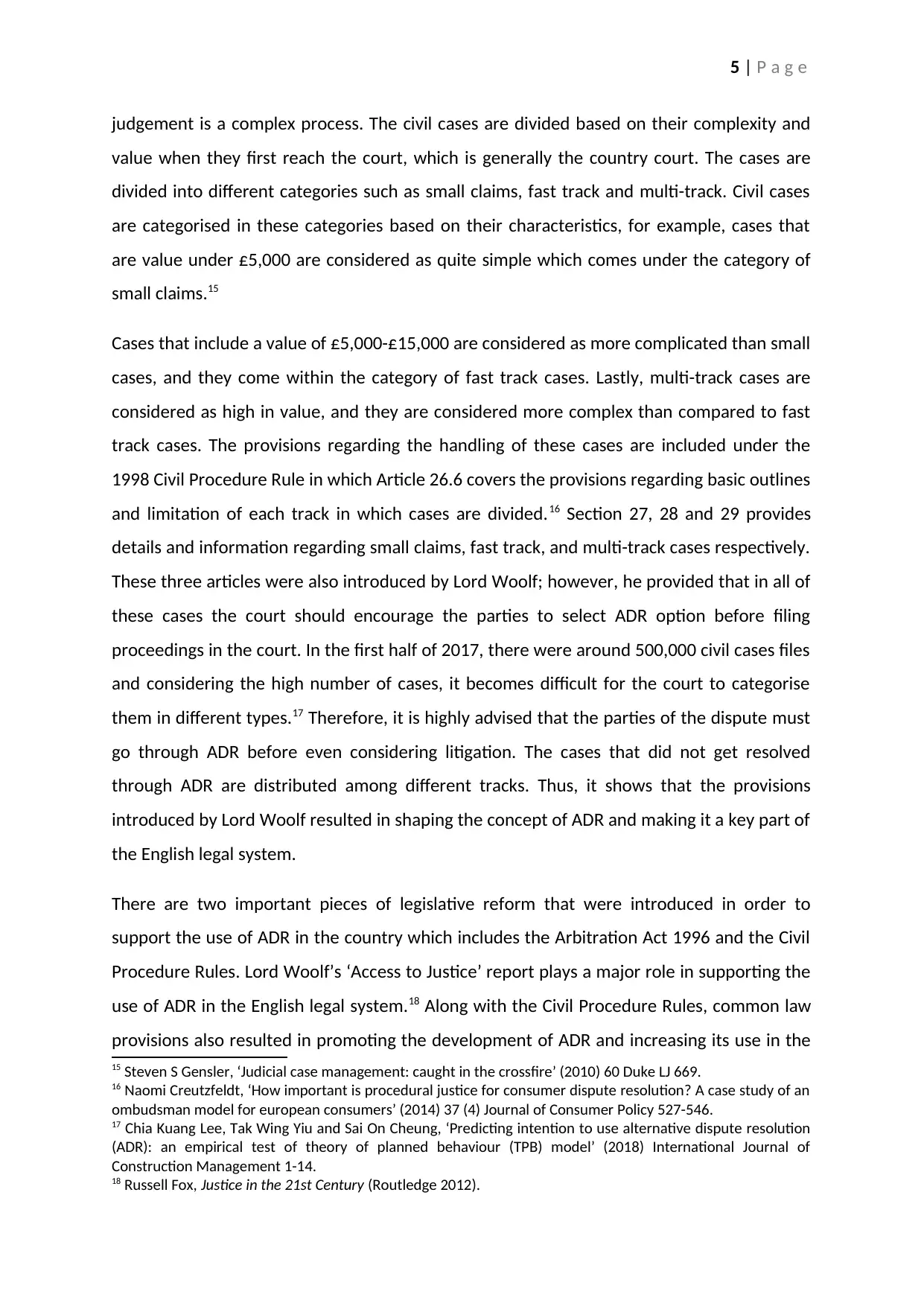
5 | P a g e
judgement is a complex process. The civil cases are divided based on their complexity and
value when they first reach the court, which is generally the country court. The cases are
divided into different categories such as small claims, fast track and multi-track. Civil cases
are categorised in these categories based on their characteristics, for example, cases that
are value under £5,000 are considered as quite simple which comes under the category of
small claims.15
Cases that include a value of £5,000-£15,000 are considered as more complicated than small
cases, and they come within the category of fast track cases. Lastly, multi-track cases are
considered as high in value, and they are considered more complex than compared to fast
track cases. The provisions regarding the handling of these cases are included under the
1998 Civil Procedure Rule in which Article 26.6 covers the provisions regarding basic outlines
and limitation of each track in which cases are divided.16 Section 27, 28 and 29 provides
details and information regarding small claims, fast track, and multi-track cases respectively.
These three articles were also introduced by Lord Woolf; however, he provided that in all of
these cases the court should encourage the parties to select ADR option before filing
proceedings in the court. In the first half of 2017, there were around 500,000 civil cases files
and considering the high number of cases, it becomes difficult for the court to categorise
them in different types.17 Therefore, it is highly advised that the parties of the dispute must
go through ADR before even considering litigation. The cases that did not get resolved
through ADR are distributed among different tracks. Thus, it shows that the provisions
introduced by Lord Woolf resulted in shaping the concept of ADR and making it a key part of
the English legal system.
There are two important pieces of legislative reform that were introduced in order to
support the use of ADR in the country which includes the Arbitration Act 1996 and the Civil
Procedure Rules. Lord Woolf’s ‘Access to Justice’ report plays a major role in supporting the
use of ADR in the English legal system.18 Along with the Civil Procedure Rules, common law
provisions also resulted in promoting the development of ADR and increasing its use in the
15 Steven S Gensler, ‘Judicial case management: caught in the crossfire’ (2010) 60 Duke LJ 669.
16 Naomi Creutzfeldt, ‘How important is procedural justice for consumer dispute resolution? A case study of an
ombudsman model for european consumers’ (2014) 37 (4) Journal of Consumer Policy 527-546.
17 Chia Kuang Lee, Tak Wing Yiu and Sai On Cheung, ‘Predicting intention to use alternative dispute resolution
(ADR): an empirical test of theory of planned behaviour (TPB) model’ (2018) International Journal of
Construction Management 1-14.
18 Russell Fox, Justice in the 21st Century (Routledge 2012).
judgement is a complex process. The civil cases are divided based on their complexity and
value when they first reach the court, which is generally the country court. The cases are
divided into different categories such as small claims, fast track and multi-track. Civil cases
are categorised in these categories based on their characteristics, for example, cases that
are value under £5,000 are considered as quite simple which comes under the category of
small claims.15
Cases that include a value of £5,000-£15,000 are considered as more complicated than small
cases, and they come within the category of fast track cases. Lastly, multi-track cases are
considered as high in value, and they are considered more complex than compared to fast
track cases. The provisions regarding the handling of these cases are included under the
1998 Civil Procedure Rule in which Article 26.6 covers the provisions regarding basic outlines
and limitation of each track in which cases are divided.16 Section 27, 28 and 29 provides
details and information regarding small claims, fast track, and multi-track cases respectively.
These three articles were also introduced by Lord Woolf; however, he provided that in all of
these cases the court should encourage the parties to select ADR option before filing
proceedings in the court. In the first half of 2017, there were around 500,000 civil cases files
and considering the high number of cases, it becomes difficult for the court to categorise
them in different types.17 Therefore, it is highly advised that the parties of the dispute must
go through ADR before even considering litigation. The cases that did not get resolved
through ADR are distributed among different tracks. Thus, it shows that the provisions
introduced by Lord Woolf resulted in shaping the concept of ADR and making it a key part of
the English legal system.
There are two important pieces of legislative reform that were introduced in order to
support the use of ADR in the country which includes the Arbitration Act 1996 and the Civil
Procedure Rules. Lord Woolf’s ‘Access to Justice’ report plays a major role in supporting the
use of ADR in the English legal system.18 Along with the Civil Procedure Rules, common law
provisions also resulted in promoting the development of ADR and increasing its use in the
15 Steven S Gensler, ‘Judicial case management: caught in the crossfire’ (2010) 60 Duke LJ 669.
16 Naomi Creutzfeldt, ‘How important is procedural justice for consumer dispute resolution? A case study of an
ombudsman model for european consumers’ (2014) 37 (4) Journal of Consumer Policy 527-546.
17 Chia Kuang Lee, Tak Wing Yiu and Sai On Cheung, ‘Predicting intention to use alternative dispute resolution
(ADR): an empirical test of theory of planned behaviour (TPB) model’ (2018) International Journal of
Construction Management 1-14.
18 Russell Fox, Justice in the 21st Century (Routledge 2012).
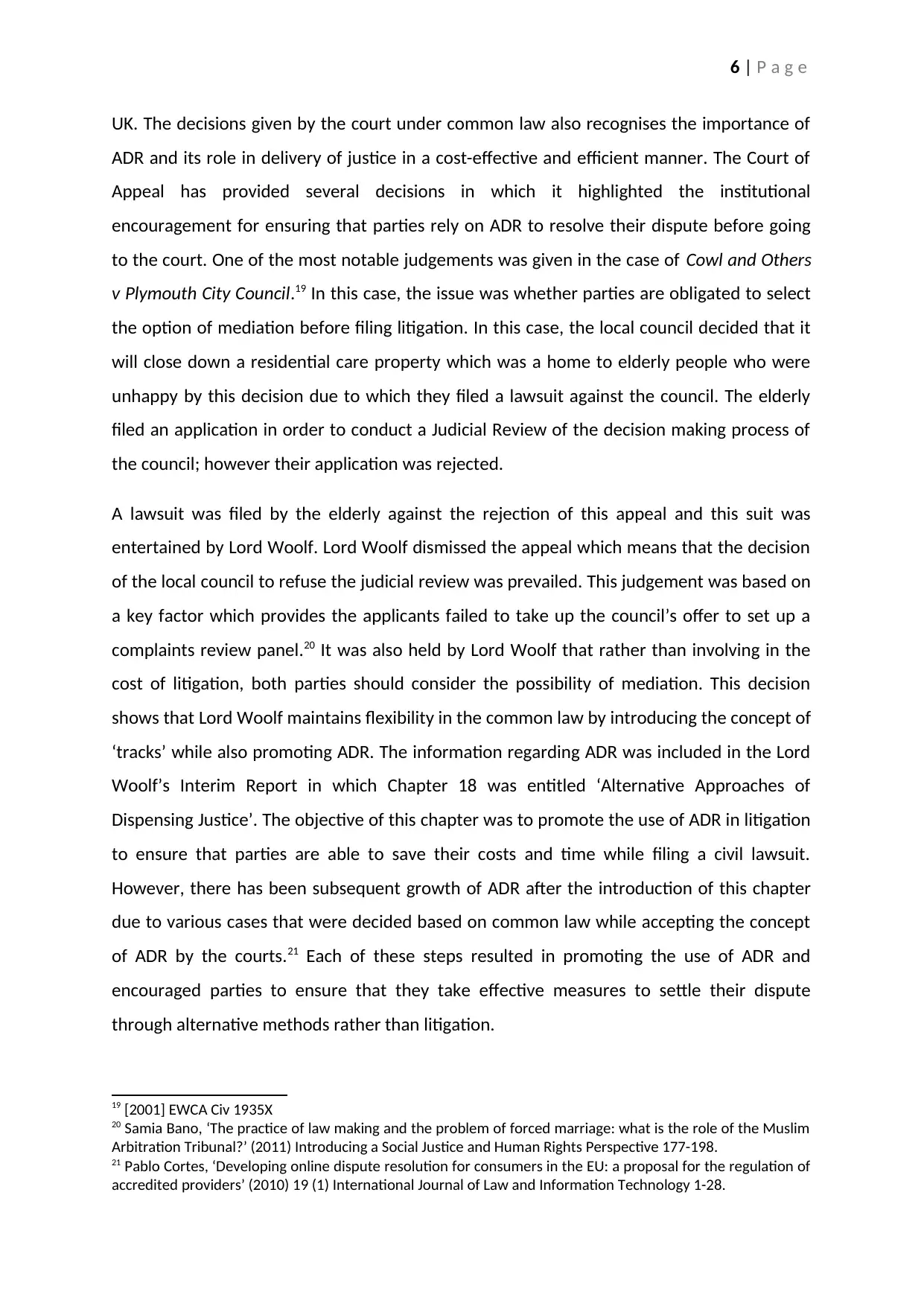
6 | P a g e
UK. The decisions given by the court under common law also recognises the importance of
ADR and its role in delivery of justice in a cost-effective and efficient manner. The Court of
Appeal has provided several decisions in which it highlighted the institutional
encouragement for ensuring that parties rely on ADR to resolve their dispute before going
to the court. One of the most notable judgements was given in the case of Cowl and Others
v Plymouth City Council.19 In this case, the issue was whether parties are obligated to select
the option of mediation before filing litigation. In this case, the local council decided that it
will close down a residential care property which was a home to elderly people who were
unhappy by this decision due to which they filed a lawsuit against the council. The elderly
filed an application in order to conduct a Judicial Review of the decision making process of
the council; however their application was rejected.
A lawsuit was filed by the elderly against the rejection of this appeal and this suit was
entertained by Lord Woolf. Lord Woolf dismissed the appeal which means that the decision
of the local council to refuse the judicial review was prevailed. This judgement was based on
a key factor which provides the applicants failed to take up the council’s offer to set up a
complaints review panel.20 It was also held by Lord Woolf that rather than involving in the
cost of litigation, both parties should consider the possibility of mediation. This decision
shows that Lord Woolf maintains flexibility in the common law by introducing the concept of
‘tracks’ while also promoting ADR. The information regarding ADR was included in the Lord
Woolf’s Interim Report in which Chapter 18 was entitled ‘Alternative Approaches of
Dispensing Justice’. The objective of this chapter was to promote the use of ADR in litigation
to ensure that parties are able to save their costs and time while filing a civil lawsuit.
However, there has been subsequent growth of ADR after the introduction of this chapter
due to various cases that were decided based on common law while accepting the concept
of ADR by the courts.21 Each of these steps resulted in promoting the use of ADR and
encouraged parties to ensure that they take effective measures to settle their dispute
through alternative methods rather than litigation.
19 [2001] EWCA Civ 1935X
20 Samia Bano, ‘The practice of law making and the problem of forced marriage: what is the role of the Muslim
Arbitration Tribunal?’ (2011) Introducing a Social Justice and Human Rights Perspective 177-198.
21 Pablo Cortes, ‘Developing online dispute resolution for consumers in the EU: a proposal for the regulation of
accredited providers’ (2010) 19 (1) International Journal of Law and Information Technology 1-28.
UK. The decisions given by the court under common law also recognises the importance of
ADR and its role in delivery of justice in a cost-effective and efficient manner. The Court of
Appeal has provided several decisions in which it highlighted the institutional
encouragement for ensuring that parties rely on ADR to resolve their dispute before going
to the court. One of the most notable judgements was given in the case of Cowl and Others
v Plymouth City Council.19 In this case, the issue was whether parties are obligated to select
the option of mediation before filing litigation. In this case, the local council decided that it
will close down a residential care property which was a home to elderly people who were
unhappy by this decision due to which they filed a lawsuit against the council. The elderly
filed an application in order to conduct a Judicial Review of the decision making process of
the council; however their application was rejected.
A lawsuit was filed by the elderly against the rejection of this appeal and this suit was
entertained by Lord Woolf. Lord Woolf dismissed the appeal which means that the decision
of the local council to refuse the judicial review was prevailed. This judgement was based on
a key factor which provides the applicants failed to take up the council’s offer to set up a
complaints review panel.20 It was also held by Lord Woolf that rather than involving in the
cost of litigation, both parties should consider the possibility of mediation. This decision
shows that Lord Woolf maintains flexibility in the common law by introducing the concept of
‘tracks’ while also promoting ADR. The information regarding ADR was included in the Lord
Woolf’s Interim Report in which Chapter 18 was entitled ‘Alternative Approaches of
Dispensing Justice’. The objective of this chapter was to promote the use of ADR in litigation
to ensure that parties are able to save their costs and time while filing a civil lawsuit.
However, there has been subsequent growth of ADR after the introduction of this chapter
due to various cases that were decided based on common law while accepting the concept
of ADR by the courts.21 Each of these steps resulted in promoting the use of ADR and
encouraged parties to ensure that they take effective measures to settle their dispute
through alternative methods rather than litigation.
19 [2001] EWCA Civ 1935X
20 Samia Bano, ‘The practice of law making and the problem of forced marriage: what is the role of the Muslim
Arbitration Tribunal?’ (2011) Introducing a Social Justice and Human Rights Perspective 177-198.
21 Pablo Cortes, ‘Developing online dispute resolution for consumers in the EU: a proposal for the regulation of
accredited providers’ (2010) 19 (1) International Journal of Law and Information Technology 1-28.
Paraphrase This Document
Need a fresh take? Get an instant paraphrase of this document with our AI Paraphraser
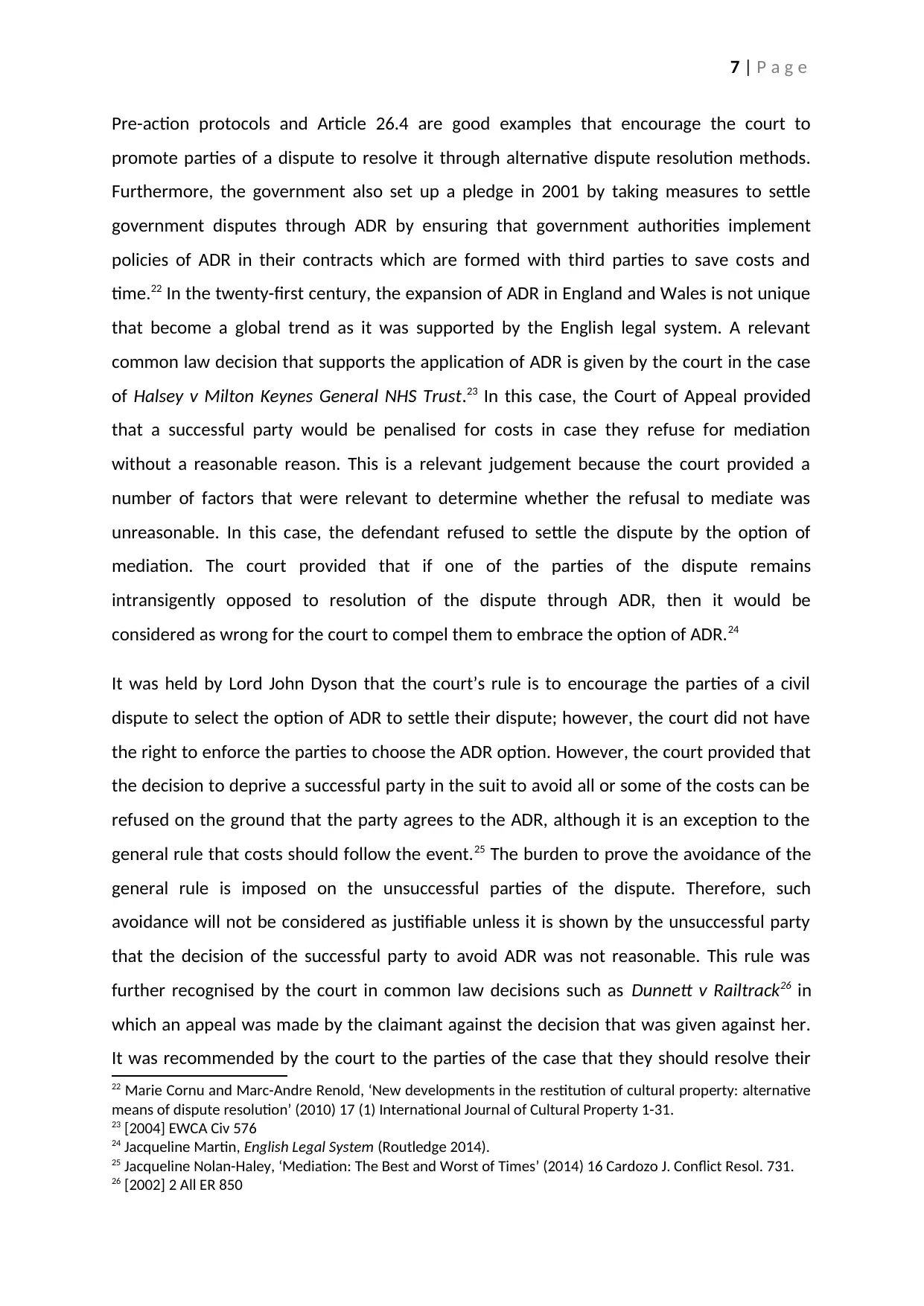
7 | P a g e
Pre-action protocols and Article 26.4 are good examples that encourage the court to
promote parties of a dispute to resolve it through alternative dispute resolution methods.
Furthermore, the government also set up a pledge in 2001 by taking measures to settle
government disputes through ADR by ensuring that government authorities implement
policies of ADR in their contracts which are formed with third parties to save costs and
time.22 In the twenty-first century, the expansion of ADR in England and Wales is not unique
that become a global trend as it was supported by the English legal system. A relevant
common law decision that supports the application of ADR is given by the court in the case
of Halsey v Milton Keynes General NHS Trust.23 In this case, the Court of Appeal provided
that a successful party would be penalised for costs in case they refuse for mediation
without a reasonable reason. This is a relevant judgement because the court provided a
number of factors that were relevant to determine whether the refusal to mediate was
unreasonable. In this case, the defendant refused to settle the dispute by the option of
mediation. The court provided that if one of the parties of the dispute remains
intransigently opposed to resolution of the dispute through ADR, then it would be
considered as wrong for the court to compel them to embrace the option of ADR.24
It was held by Lord John Dyson that the court’s rule is to encourage the parties of a civil
dispute to select the option of ADR to settle their dispute; however, the court did not have
the right to enforce the parties to choose the ADR option. However, the court provided that
the decision to deprive a successful party in the suit to avoid all or some of the costs can be
refused on the ground that the party agrees to the ADR, although it is an exception to the
general rule that costs should follow the event.25 The burden to prove the avoidance of the
general rule is imposed on the unsuccessful parties of the dispute. Therefore, such
avoidance will not be considered as justifiable unless it is shown by the unsuccessful party
that the decision of the successful party to avoid ADR was not reasonable. This rule was
further recognised by the court in common law decisions such as Dunnett v Railtrack26 in
which an appeal was made by the claimant against the decision that was given against her.
It was recommended by the court to the parties of the case that they should resolve their
22 Marie Cornu and Marc-Andre Renold, ‘New developments in the restitution of cultural property: alternative
means of dispute resolution’ (2010) 17 (1) International Journal of Cultural Property 1-31.
23 [2004] EWCA Civ 576
24 Jacqueline Martin, English Legal System (Routledge 2014).
25 Jacqueline Nolan-Haley, ‘Mediation: The Best and Worst of Times’ (2014) 16 Cardozo J. Conflict Resol. 731.
26 [2002] 2 All ER 850
Pre-action protocols and Article 26.4 are good examples that encourage the court to
promote parties of a dispute to resolve it through alternative dispute resolution methods.
Furthermore, the government also set up a pledge in 2001 by taking measures to settle
government disputes through ADR by ensuring that government authorities implement
policies of ADR in their contracts which are formed with third parties to save costs and
time.22 In the twenty-first century, the expansion of ADR in England and Wales is not unique
that become a global trend as it was supported by the English legal system. A relevant
common law decision that supports the application of ADR is given by the court in the case
of Halsey v Milton Keynes General NHS Trust.23 In this case, the Court of Appeal provided
that a successful party would be penalised for costs in case they refuse for mediation
without a reasonable reason. This is a relevant judgement because the court provided a
number of factors that were relevant to determine whether the refusal to mediate was
unreasonable. In this case, the defendant refused to settle the dispute by the option of
mediation. The court provided that if one of the parties of the dispute remains
intransigently opposed to resolution of the dispute through ADR, then it would be
considered as wrong for the court to compel them to embrace the option of ADR.24
It was held by Lord John Dyson that the court’s rule is to encourage the parties of a civil
dispute to select the option of ADR to settle their dispute; however, the court did not have
the right to enforce the parties to choose the ADR option. However, the court provided that
the decision to deprive a successful party in the suit to avoid all or some of the costs can be
refused on the ground that the party agrees to the ADR, although it is an exception to the
general rule that costs should follow the event.25 The burden to prove the avoidance of the
general rule is imposed on the unsuccessful parties of the dispute. Therefore, such
avoidance will not be considered as justifiable unless it is shown by the unsuccessful party
that the decision of the successful party to avoid ADR was not reasonable. This rule was
further recognised by the court in common law decisions such as Dunnett v Railtrack26 in
which an appeal was made by the claimant against the decision that was given against her.
It was recommended by the court to the parties of the case that they should resolve their
22 Marie Cornu and Marc-Andre Renold, ‘New developments in the restitution of cultural property: alternative
means of dispute resolution’ (2010) 17 (1) International Journal of Cultural Property 1-31.
23 [2004] EWCA Civ 576
24 Jacqueline Martin, English Legal System (Routledge 2014).
25 Jacqueline Nolan-Haley, ‘Mediation: The Best and Worst of Times’ (2014) 16 Cardozo J. Conflict Resol. 731.
26 [2002] 2 All ER 850
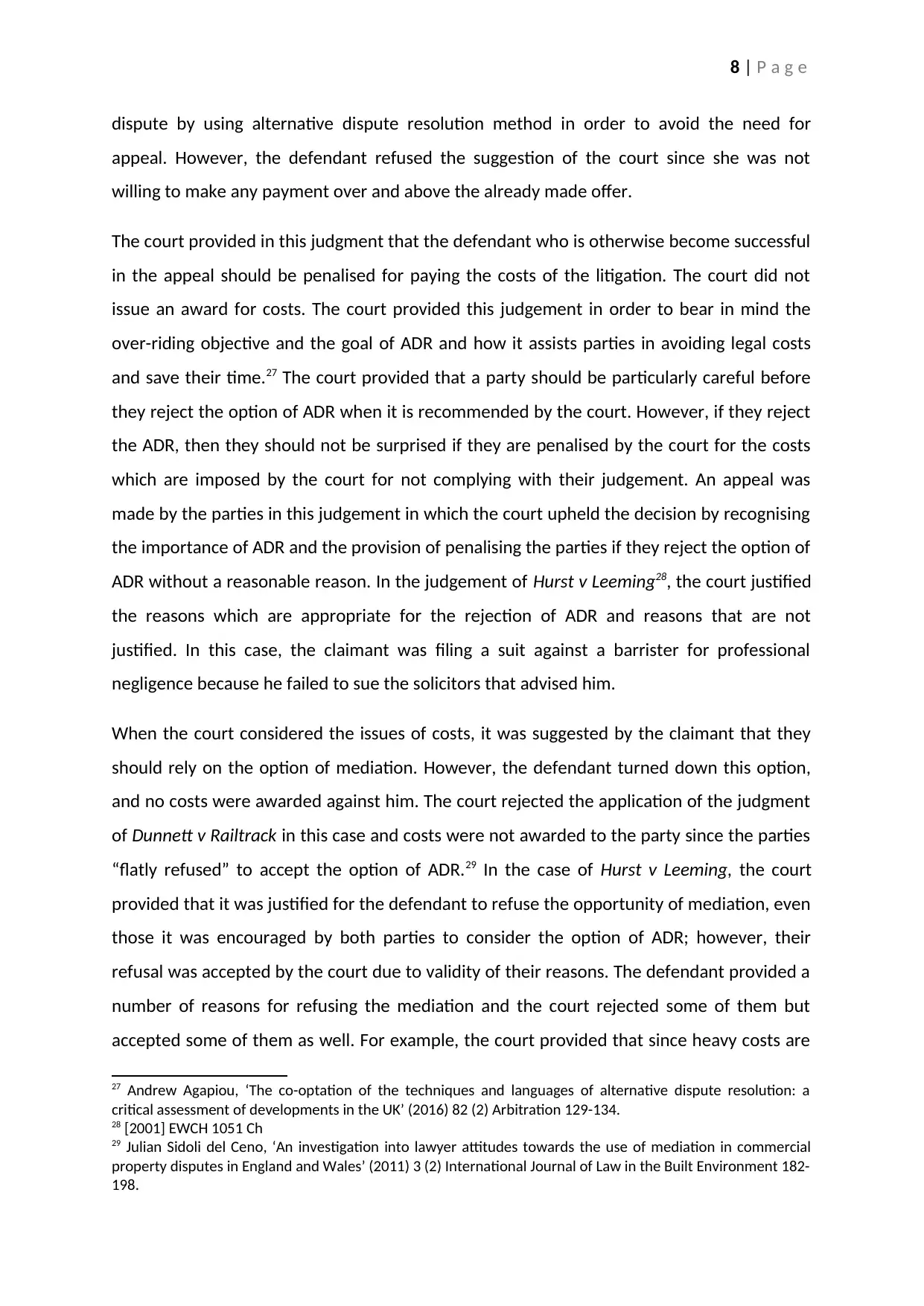
8 | P a g e
dispute by using alternative dispute resolution method in order to avoid the need for
appeal. However, the defendant refused the suggestion of the court since she was not
willing to make any payment over and above the already made offer.
The court provided in this judgment that the defendant who is otherwise become successful
in the appeal should be penalised for paying the costs of the litigation. The court did not
issue an award for costs. The court provided this judgement in order to bear in mind the
over-riding objective and the goal of ADR and how it assists parties in avoiding legal costs
and save their time.27 The court provided that a party should be particularly careful before
they reject the option of ADR when it is recommended by the court. However, if they reject
the ADR, then they should not be surprised if they are penalised by the court for the costs
which are imposed by the court for not complying with their judgement. An appeal was
made by the parties in this judgement in which the court upheld the decision by recognising
the importance of ADR and the provision of penalising the parties if they reject the option of
ADR without a reasonable reason. In the judgement of Hurst v Leeming28, the court justified
the reasons which are appropriate for the rejection of ADR and reasons that are not
justified. In this case, the claimant was filing a suit against a barrister for professional
negligence because he failed to sue the solicitors that advised him.
When the court considered the issues of costs, it was suggested by the claimant that they
should rely on the option of mediation. However, the defendant turned down this option,
and no costs were awarded against him. The court rejected the application of the judgment
of Dunnett v Railtrack in this case and costs were not awarded to the party since the parties
“flatly refused” to accept the option of ADR.29 In the case of Hurst v Leeming, the court
provided that it was justified for the defendant to refuse the opportunity of mediation, even
those it was encouraged by both parties to consider the option of ADR; however, their
refusal was accepted by the court due to validity of their reasons. The defendant provided a
number of reasons for refusing the mediation and the court rejected some of them but
accepted some of them as well. For example, the court provided that since heavy costs are
27 Andrew Agapiou, ‘The co-optation of the techniques and languages of alternative dispute resolution: a
critical assessment of developments in the UK’ (2016) 82 (2) Arbitration 129-134.
28 [2001] EWCH 1051 Ch
29 Julian Sidoli del Ceno, ‘An investigation into lawyer attitudes towards the use of mediation in commercial
property disputes in England and Wales’ (2011) 3 (2) International Journal of Law in the Built Environment 182-
198.
dispute by using alternative dispute resolution method in order to avoid the need for
appeal. However, the defendant refused the suggestion of the court since she was not
willing to make any payment over and above the already made offer.
The court provided in this judgment that the defendant who is otherwise become successful
in the appeal should be penalised for paying the costs of the litigation. The court did not
issue an award for costs. The court provided this judgement in order to bear in mind the
over-riding objective and the goal of ADR and how it assists parties in avoiding legal costs
and save their time.27 The court provided that a party should be particularly careful before
they reject the option of ADR when it is recommended by the court. However, if they reject
the ADR, then they should not be surprised if they are penalised by the court for the costs
which are imposed by the court for not complying with their judgement. An appeal was
made by the parties in this judgement in which the court upheld the decision by recognising
the importance of ADR and the provision of penalising the parties if they reject the option of
ADR without a reasonable reason. In the judgement of Hurst v Leeming28, the court justified
the reasons which are appropriate for the rejection of ADR and reasons that are not
justified. In this case, the claimant was filing a suit against a barrister for professional
negligence because he failed to sue the solicitors that advised him.
When the court considered the issues of costs, it was suggested by the claimant that they
should rely on the option of mediation. However, the defendant turned down this option,
and no costs were awarded against him. The court rejected the application of the judgment
of Dunnett v Railtrack in this case and costs were not awarded to the party since the parties
“flatly refused” to accept the option of ADR.29 In the case of Hurst v Leeming, the court
provided that it was justified for the defendant to refuse the opportunity of mediation, even
those it was encouraged by both parties to consider the option of ADR; however, their
refusal was accepted by the court due to validity of their reasons. The defendant provided a
number of reasons for refusing the mediation and the court rejected some of them but
accepted some of them as well. For example, the court provided that since heavy costs are
27 Andrew Agapiou, ‘The co-optation of the techniques and languages of alternative dispute resolution: a
critical assessment of developments in the UK’ (2016) 82 (2) Arbitration 129-134.
28 [2001] EWCH 1051 Ch
29 Julian Sidoli del Ceno, ‘An investigation into lawyer attitudes towards the use of mediation in commercial
property disputes in England and Wales’ (2011) 3 (2) International Journal of Law in the Built Environment 182-
198.
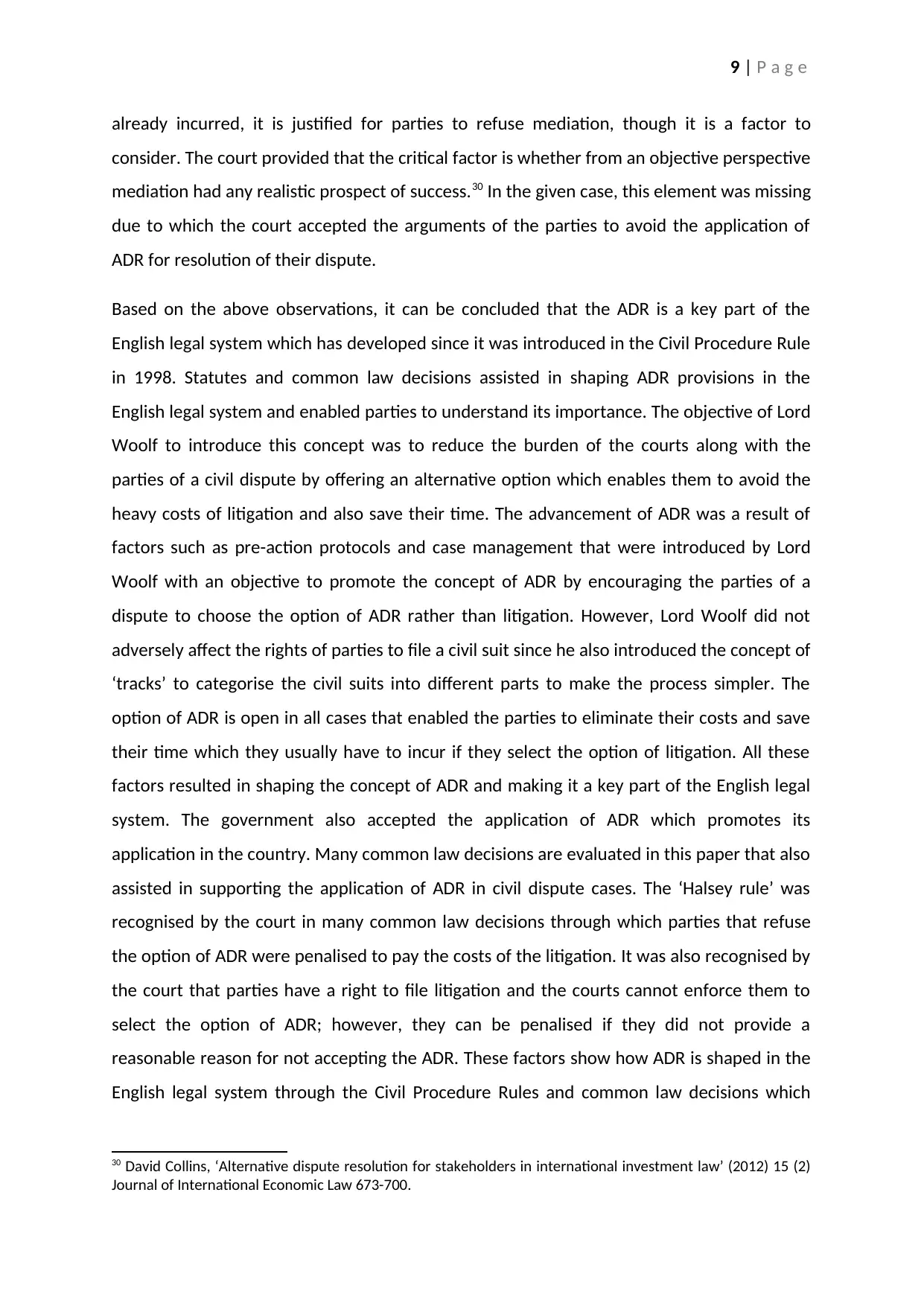
9 | P a g e
already incurred, it is justified for parties to refuse mediation, though it is a factor to
consider. The court provided that the critical factor is whether from an objective perspective
mediation had any realistic prospect of success.30 In the given case, this element was missing
due to which the court accepted the arguments of the parties to avoid the application of
ADR for resolution of their dispute.
Based on the above observations, it can be concluded that the ADR is a key part of the
English legal system which has developed since it was introduced in the Civil Procedure Rule
in 1998. Statutes and common law decisions assisted in shaping ADR provisions in the
English legal system and enabled parties to understand its importance. The objective of Lord
Woolf to introduce this concept was to reduce the burden of the courts along with the
parties of a civil dispute by offering an alternative option which enables them to avoid the
heavy costs of litigation and also save their time. The advancement of ADR was a result of
factors such as pre-action protocols and case management that were introduced by Lord
Woolf with an objective to promote the concept of ADR by encouraging the parties of a
dispute to choose the option of ADR rather than litigation. However, Lord Woolf did not
adversely affect the rights of parties to file a civil suit since he also introduced the concept of
‘tracks’ to categorise the civil suits into different parts to make the process simpler. The
option of ADR is open in all cases that enabled the parties to eliminate their costs and save
their time which they usually have to incur if they select the option of litigation. All these
factors resulted in shaping the concept of ADR and making it a key part of the English legal
system. The government also accepted the application of ADR which promotes its
application in the country. Many common law decisions are evaluated in this paper that also
assisted in supporting the application of ADR in civil dispute cases. The ‘Halsey rule’ was
recognised by the court in many common law decisions through which parties that refuse
the option of ADR were penalised to pay the costs of the litigation. It was also recognised by
the court that parties have a right to file litigation and the courts cannot enforce them to
select the option of ADR; however, they can be penalised if they did not provide a
reasonable reason for not accepting the ADR. These factors show how ADR is shaped in the
English legal system through the Civil Procedure Rules and common law decisions which
30 David Collins, ‘Alternative dispute resolution for stakeholders in international investment law’ (2012) 15 (2)
Journal of International Economic Law 673-700.
already incurred, it is justified for parties to refuse mediation, though it is a factor to
consider. The court provided that the critical factor is whether from an objective perspective
mediation had any realistic prospect of success.30 In the given case, this element was missing
due to which the court accepted the arguments of the parties to avoid the application of
ADR for resolution of their dispute.
Based on the above observations, it can be concluded that the ADR is a key part of the
English legal system which has developed since it was introduced in the Civil Procedure Rule
in 1998. Statutes and common law decisions assisted in shaping ADR provisions in the
English legal system and enabled parties to understand its importance. The objective of Lord
Woolf to introduce this concept was to reduce the burden of the courts along with the
parties of a civil dispute by offering an alternative option which enables them to avoid the
heavy costs of litigation and also save their time. The advancement of ADR was a result of
factors such as pre-action protocols and case management that were introduced by Lord
Woolf with an objective to promote the concept of ADR by encouraging the parties of a
dispute to choose the option of ADR rather than litigation. However, Lord Woolf did not
adversely affect the rights of parties to file a civil suit since he also introduced the concept of
‘tracks’ to categorise the civil suits into different parts to make the process simpler. The
option of ADR is open in all cases that enabled the parties to eliminate their costs and save
their time which they usually have to incur if they select the option of litigation. All these
factors resulted in shaping the concept of ADR and making it a key part of the English legal
system. The government also accepted the application of ADR which promotes its
application in the country. Many common law decisions are evaluated in this paper that also
assisted in supporting the application of ADR in civil dispute cases. The ‘Halsey rule’ was
recognised by the court in many common law decisions through which parties that refuse
the option of ADR were penalised to pay the costs of the litigation. It was also recognised by
the court that parties have a right to file litigation and the courts cannot enforce them to
select the option of ADR; however, they can be penalised if they did not provide a
reasonable reason for not accepting the ADR. These factors show how ADR is shaped in the
English legal system through the Civil Procedure Rules and common law decisions which
30 David Collins, ‘Alternative dispute resolution for stakeholders in international investment law’ (2012) 15 (2)
Journal of International Economic Law 673-700.
Secure Best Marks with AI Grader
Need help grading? Try our AI Grader for instant feedback on your assignments.
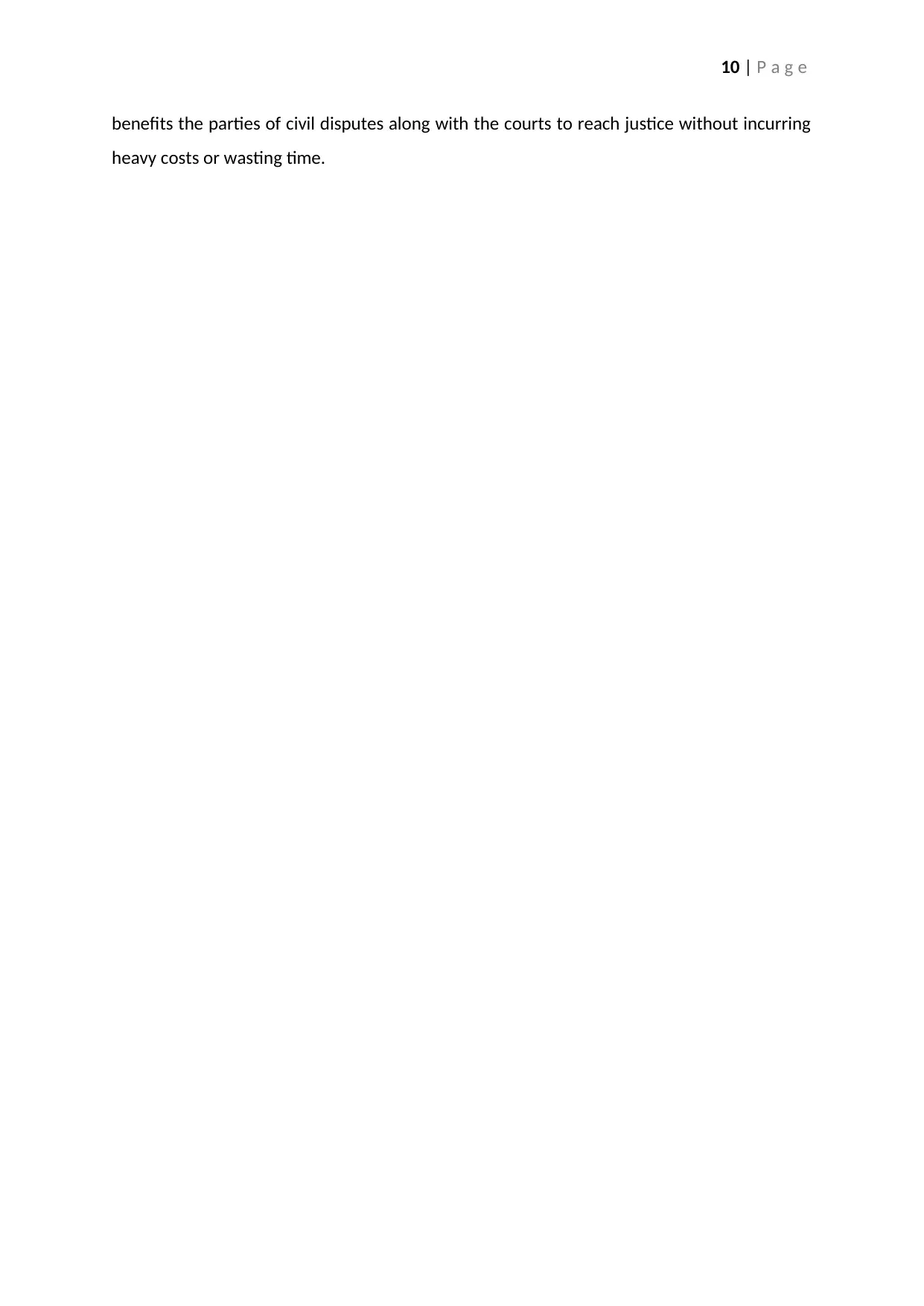
10 | P a g e
benefits the parties of civil disputes along with the courts to reach justice without incurring
heavy costs or wasting time.
benefits the parties of civil disputes along with the courts to reach justice without incurring
heavy costs or wasting time.

11 | P a g e
Bibliography
Books
Blake SH, Browne J and Sime S, A practical approach to alternative dispute resolution
(Oxford University Press 2016).
Fiadjoe A, Alternative dispute resolution: a developing world perspective (Routledge 2013).
Fox R, Justice in the 21st Century (Routledge 2012).
Mackie KJ and Mackie K, A handbook of dispute resolution: ADR in action (Routledge 2013).
Martin J, English Legal System (Routledge 2014).
Menkel-Meadow C, Dispute processing and conflict resolution: theory, practice and policy
(Routledge 2017).
Moffitt ML and Bordone RC, The handbook of dispute resolution (JWS 2012).
Ramsbotham O, Maill H and Woodhouse T, Contemporary conflict resolution (Polity 2011).
Articles
Agapiou A, ‘The co-optation of the techniques and languages of alternative dispute
resolution: a critical assessment of developments in the UK’ (2016) 82 (2) Arbitration 129-
134.
Bano S, ‘The practice of law making and the problem of forced marriage: what is the role of
the Muslim Arbitration Tribunal?’ (2011) ISJHRP 177-198.
ChongHY and Zin RM, ‘Selection of dispute resolution methods: factor analysis approach’
(2012) 19 (4) ECAM 428-443.
Collins D, ‘Alternative dispute resolution for stakeholders in international investment law’
(2012) 15 (2) JIEL 673-700.
Cornu M and Renold MA, ‘New developments in the restitution of cultural property:
alternative means of dispute resolution’ (2010) 17 (1) IJCP 1-31.
Bibliography
Books
Blake SH, Browne J and Sime S, A practical approach to alternative dispute resolution
(Oxford University Press 2016).
Fiadjoe A, Alternative dispute resolution: a developing world perspective (Routledge 2013).
Fox R, Justice in the 21st Century (Routledge 2012).
Mackie KJ and Mackie K, A handbook of dispute resolution: ADR in action (Routledge 2013).
Martin J, English Legal System (Routledge 2014).
Menkel-Meadow C, Dispute processing and conflict resolution: theory, practice and policy
(Routledge 2017).
Moffitt ML and Bordone RC, The handbook of dispute resolution (JWS 2012).
Ramsbotham O, Maill H and Woodhouse T, Contemporary conflict resolution (Polity 2011).
Articles
Agapiou A, ‘The co-optation of the techniques and languages of alternative dispute
resolution: a critical assessment of developments in the UK’ (2016) 82 (2) Arbitration 129-
134.
Bano S, ‘The practice of law making and the problem of forced marriage: what is the role of
the Muslim Arbitration Tribunal?’ (2011) ISJHRP 177-198.
ChongHY and Zin RM, ‘Selection of dispute resolution methods: factor analysis approach’
(2012) 19 (4) ECAM 428-443.
Collins D, ‘Alternative dispute resolution for stakeholders in international investment law’
(2012) 15 (2) JIEL 673-700.
Cornu M and Renold MA, ‘New developments in the restitution of cultural property:
alternative means of dispute resolution’ (2010) 17 (1) IJCP 1-31.

12 | P a g e
Cortes P, ‘Developing online dispute resolution for consumers in the EU: a proposal for the
regulation of accredited providers’ (2010) 19 (1) IJLIT 1-28.
Creutzfeldt N, ‘How important is procedural justice for consumer dispute resolution? A case
study of an ombudsman model for european consumers’ (2014) 37 (4) JCP 527-546.
Genn H, ‘What is Civil Justice For-Reform, ADR, and Access to Justice’ (2012) 24 YJLH 397.
Gensler SS, ‘Judicial case management: caught in the crossfire’ (2010) 60 DLJ 669.
Lee CK, Yiu TW and Cheung SO, ‘Predicting intention to use alternative dispute resolution
(ADR): an empirical test of theory of planned behaviour (TPB) model’ (2018) IJCM 1-14.
Mulcahy L, ‘The collective interest in private dispute resolution’ (2012) 33 (1) OJLS 59-80.
Mulcahy L, ‘The collective interest in private dispute resolution’ (2012) 33 (1) OJLS 59-80.
Nolan-Haley J, ‘Mediation: The Best and Worst of Times’ (2014) 16 CJCR 731.
Ridley-Duff R and Bennett A, ‘Towards mediation: developing a theoretical framework to
understand alternative dispute resolution’ (2011) 42 (2) IRJ 106-123.
Sidoli del Ceno J, ‘An investigation into lawyer attitudes towards the use of mediation in
commercial property disputes in England and Wales’ (2011) 3 (2) IJLBE 182-198.
Sohn DH and Bal BS, ‘Medical malpractice reform: the role of alternative dispute resolution’
(2012) 470 (5) CORR 1370-1378.
Soudrin t, ‘Civil Dispute Resolution Obligations: What is Reasonable’ (2012) 35 UNSWLJ 889.
Tzankova IN, ‘Case management: the stepchild of mass claim dispute resolution’ (2014) 19
(3) ULR 329-350.
Cases
Cowl and Others v Plymouth City Council [2001] EWCA Civ 1935X
Dunnett v Railtrack [2002] 2 All ER 850
Halsey v Milton Keynes General NHS Trust [2004] EWCA Civ 576
Cortes P, ‘Developing online dispute resolution for consumers in the EU: a proposal for the
regulation of accredited providers’ (2010) 19 (1) IJLIT 1-28.
Creutzfeldt N, ‘How important is procedural justice for consumer dispute resolution? A case
study of an ombudsman model for european consumers’ (2014) 37 (4) JCP 527-546.
Genn H, ‘What is Civil Justice For-Reform, ADR, and Access to Justice’ (2012) 24 YJLH 397.
Gensler SS, ‘Judicial case management: caught in the crossfire’ (2010) 60 DLJ 669.
Lee CK, Yiu TW and Cheung SO, ‘Predicting intention to use alternative dispute resolution
(ADR): an empirical test of theory of planned behaviour (TPB) model’ (2018) IJCM 1-14.
Mulcahy L, ‘The collective interest in private dispute resolution’ (2012) 33 (1) OJLS 59-80.
Mulcahy L, ‘The collective interest in private dispute resolution’ (2012) 33 (1) OJLS 59-80.
Nolan-Haley J, ‘Mediation: The Best and Worst of Times’ (2014) 16 CJCR 731.
Ridley-Duff R and Bennett A, ‘Towards mediation: developing a theoretical framework to
understand alternative dispute resolution’ (2011) 42 (2) IRJ 106-123.
Sidoli del Ceno J, ‘An investigation into lawyer attitudes towards the use of mediation in
commercial property disputes in England and Wales’ (2011) 3 (2) IJLBE 182-198.
Sohn DH and Bal BS, ‘Medical malpractice reform: the role of alternative dispute resolution’
(2012) 470 (5) CORR 1370-1378.
Soudrin t, ‘Civil Dispute Resolution Obligations: What is Reasonable’ (2012) 35 UNSWLJ 889.
Tzankova IN, ‘Case management: the stepchild of mass claim dispute resolution’ (2014) 19
(3) ULR 329-350.
Cases
Cowl and Others v Plymouth City Council [2001] EWCA Civ 1935X
Dunnett v Railtrack [2002] 2 All ER 850
Halsey v Milton Keynes General NHS Trust [2004] EWCA Civ 576
Paraphrase This Document
Need a fresh take? Get an instant paraphrase of this document with our AI Paraphraser
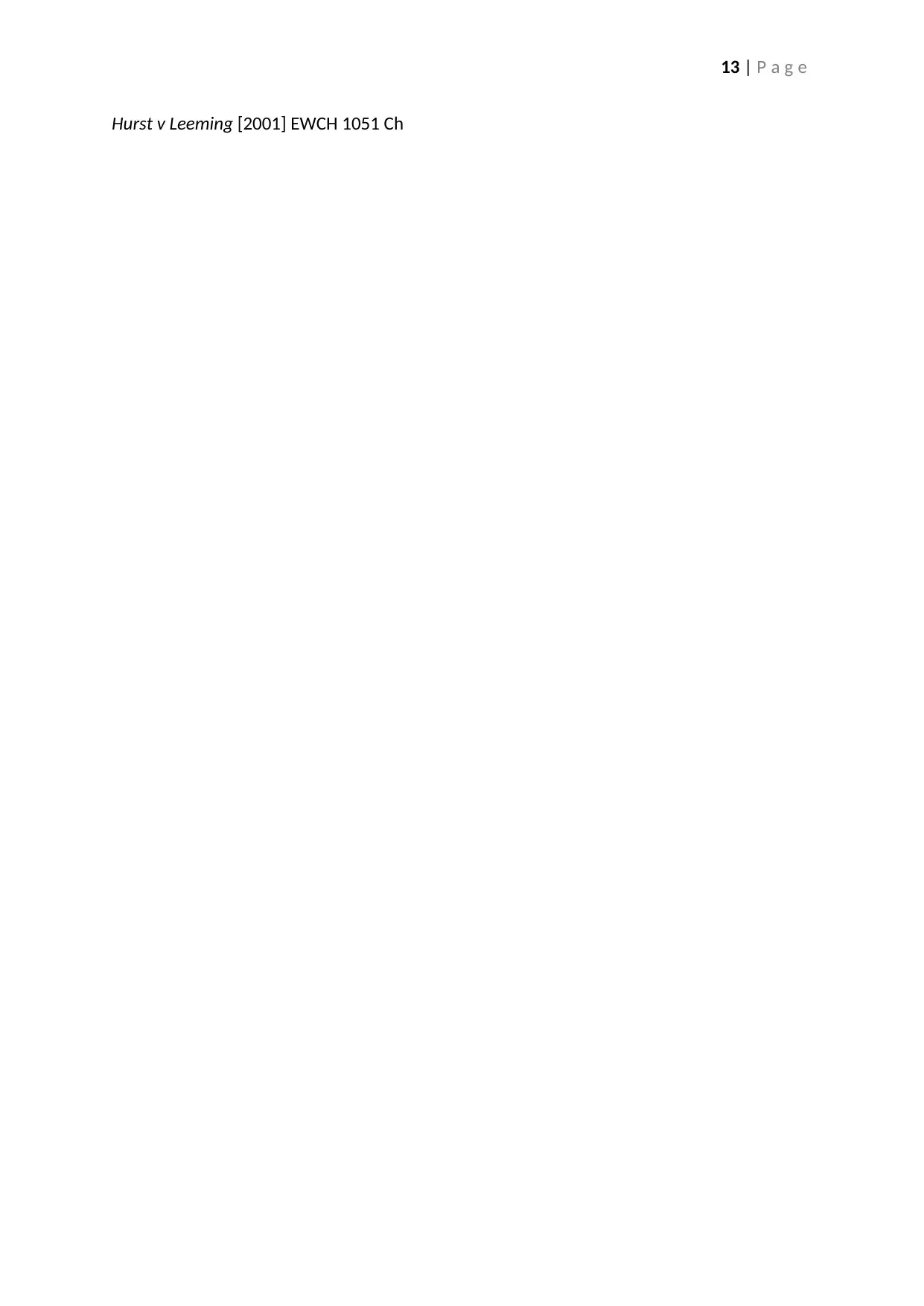
13 | P a g e
Hurst v Leeming [2001] EWCH 1051 Ch
Hurst v Leeming [2001] EWCH 1051 Ch
1 out of 14
Related Documents
Your All-in-One AI-Powered Toolkit for Academic Success.
+13062052269
info@desklib.com
Available 24*7 on WhatsApp / Email
![[object Object]](/_next/static/media/star-bottom.7253800d.svg)
Unlock your academic potential
© 2024 | Zucol Services PVT LTD | All rights reserved.





